I tested the most popular rival to Le Creuset cast iron - is it a chef's best kept secret?
The Staub La Cocotte Casserole Dish is traditional French cooking at its finest

Le Creuset's biggest rival has a lot to recommend it: elegant design, exceptional quality, and incredible versatility. It's the best casserole dish I've used when it comes to locking in moisture and handling wear-and-tear, but it's also the heaviest.
-
+
Timeless design available in 16 colours
-
+
Incredible heat transfer and retention
-
+
Self-basting lid locks in moisture
-
+
Lifetime guarantee
-
-
Expensive
-
-
Heaviest cast iron tested
-
-
Some struggle with black enamel
Why you can trust Woman & Home

What do the French know about cooking? I give you Coq au Vin, French Onion Soup, and Boef Bourgingon. What do the French know about style? Silly question, really. Absolutely everything. Combine the two and that's when you get Staub's La Cocotte Cast Iron Casserole Dishes: where timeless French craftsmanship meets kitchen couture.
The brand stands as Le Creuset’s greatest rival in the world of cast iron casserole dishes. Staub’s ability to brown, braise, and baste precedes itself, which is why I had to get one into the kitchen for testing.
If you're passionate about cooking you'll have already made your way through all the questions I sought to answer: is Staub worth the money? Is it better than Le Creuset? And did this cast iron casserole dish earn a spot in my kitchen cupboard? You’re about to find out.
Staub La Cocotte Round Cast Iron Casserole Dish review
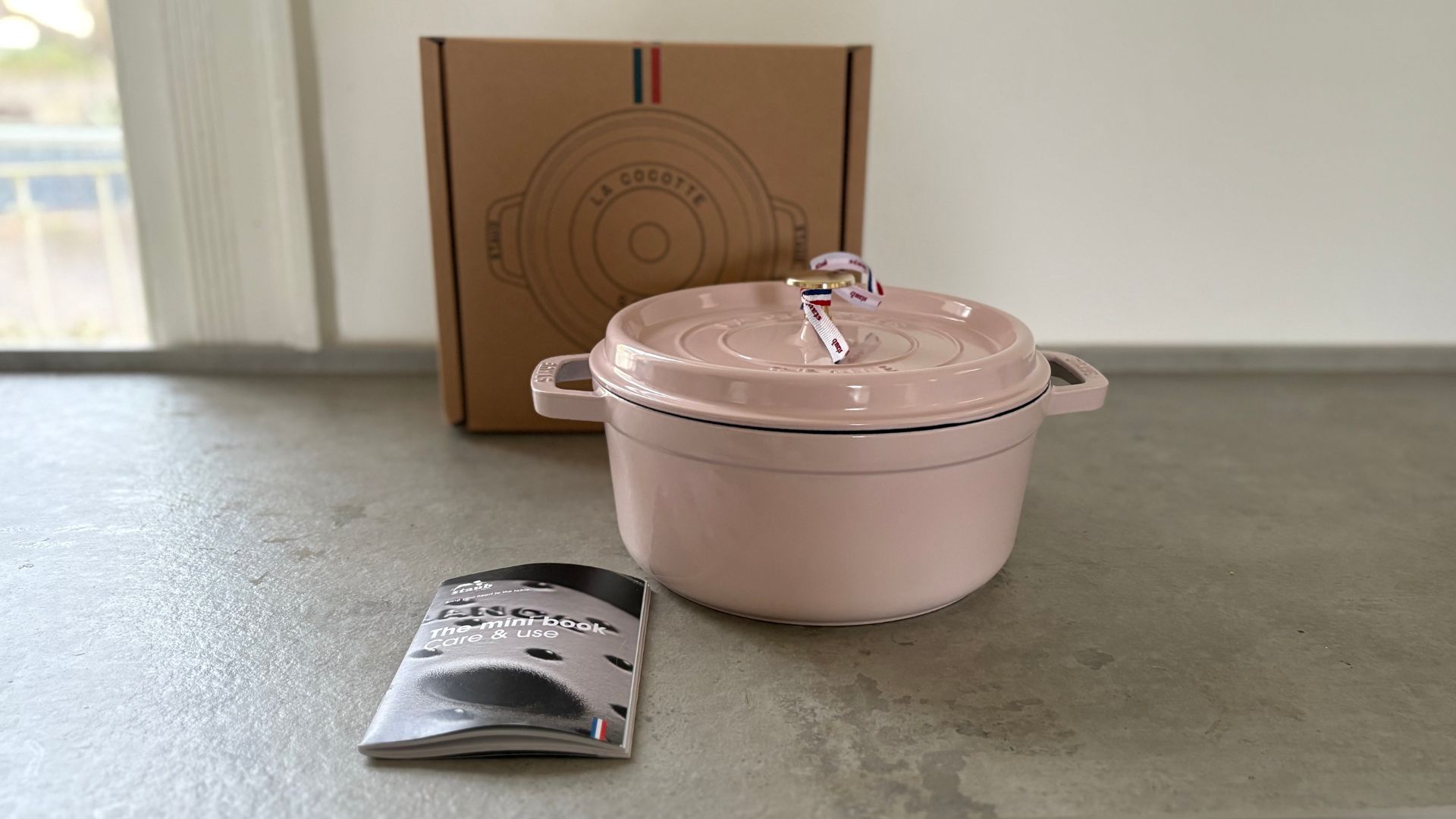
Sizes | 12-34cm |
Colours | Take your pick from 16 options |
Material | Cast iron |
Coating | Enamel |
Hob compatability | All |
Oven safe | Up to 260 ºC |
Freezer safe | Down to -20 ºC |
Dishwasher safe | Yes |
Weight | 1.4-10 kgs |
Capacity | 0.3-12.6L |
Who would the Staub La Cocotte Round Cast Iron Casserole Dish suit?
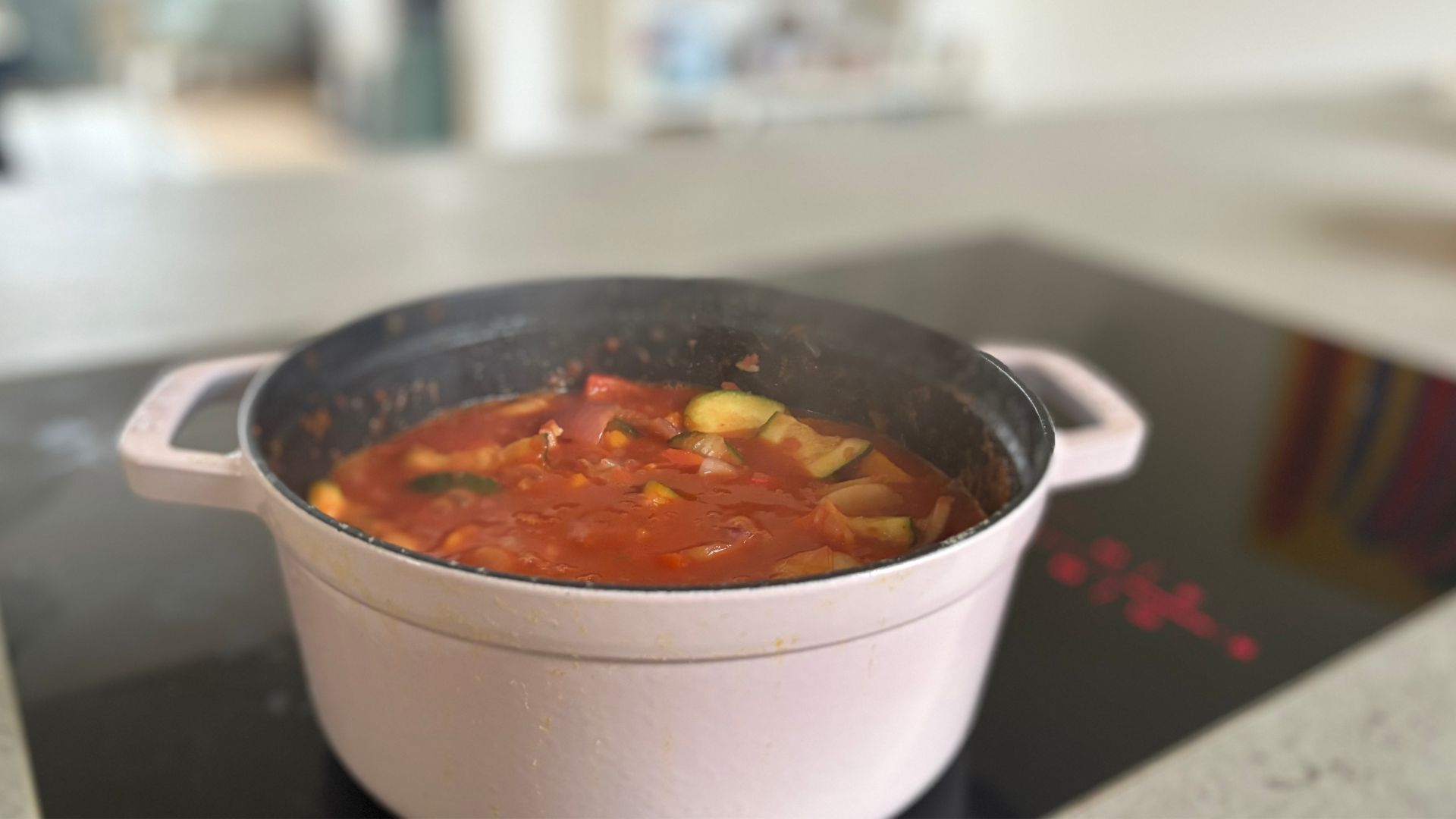
Unsurprisingly for a brand like this, Staub suits traditional cooks, those who appreciate craftsmanship and hearty, home-style cooking. The robust cast iron build reminds me of the pots my grandma used, and they look the part too. But don’t mistake that for dated design; these dishes are classics for a reason. The self-basting lid, for instance, has been part of STAUB’s design for nearly half a century and still performs beautifully, locking in moisture and flavour.
The Staub La Cocotte range comes in 16 colours and a variety of sizes, from petite 0.3L dishes to generous 12L casseroles. That makes it ideal for everyone from solo cooks to big family entertainers. My advice: choose wisely. Staub Cast Iron Casserole Dishes are pieces are pricey, but they’re also an investment that’ll last a lifetime. I tend to favour the timeless hues, though there are plenty of bold colours if you’d rather make a statement.
Inside, each pan has a black enamel finish, which is great if you’re prone to scratching your cookware. Some people find it harder to see when food is browning, but I didn’t find that an issue. Personally, I’d rather have a pan that hides the wear.
One final note: STAUB casseroles are heavy (even more so than Le Creuset). That weight comes from their exceptional heat retention and thick enamel coating. It’s part of what makes them perform so well, but lifting a full one out of the oven does call for a bit of wrist and arm strength.
Sign up to our free daily email for the latest royal and entertainment news, interesting opinion, expert advice on styling and beauty trends, and no-nonsense guides to the health and wellness questions you want answered.
Unboxing the Staub La Cocotte Round Cast Iron Casserole Dish

Staub is brilliant with their delivery. It’s speedy, compact, and eco-conscious. You’ll have an outer box that’s all recyclable, as well as a more robust carboard box that lots of people hold onto for storing their cast iron casseroles. Your Staub La Cocotte Cast Iron Casserole Dish will fit perfectly inside and I would recommend holding on to your little plastic clips that get gripped around the edges of the dish. These stop the lid from scratching the main body when the pan gets knocked around.
You can see that I was testing a pan in their new sorbet rose colour. I said I would always go for traditional hues, but I really fell in love with the delicate pink. Everyone commented that it suited me and my pink nails (I’ll take that as a compliment) and we labelled it firmly as very French farmhouse chic, with a touch of barbie.
What is the Staub La Cocotte Round Cast Iron Casserole Dish like to use?
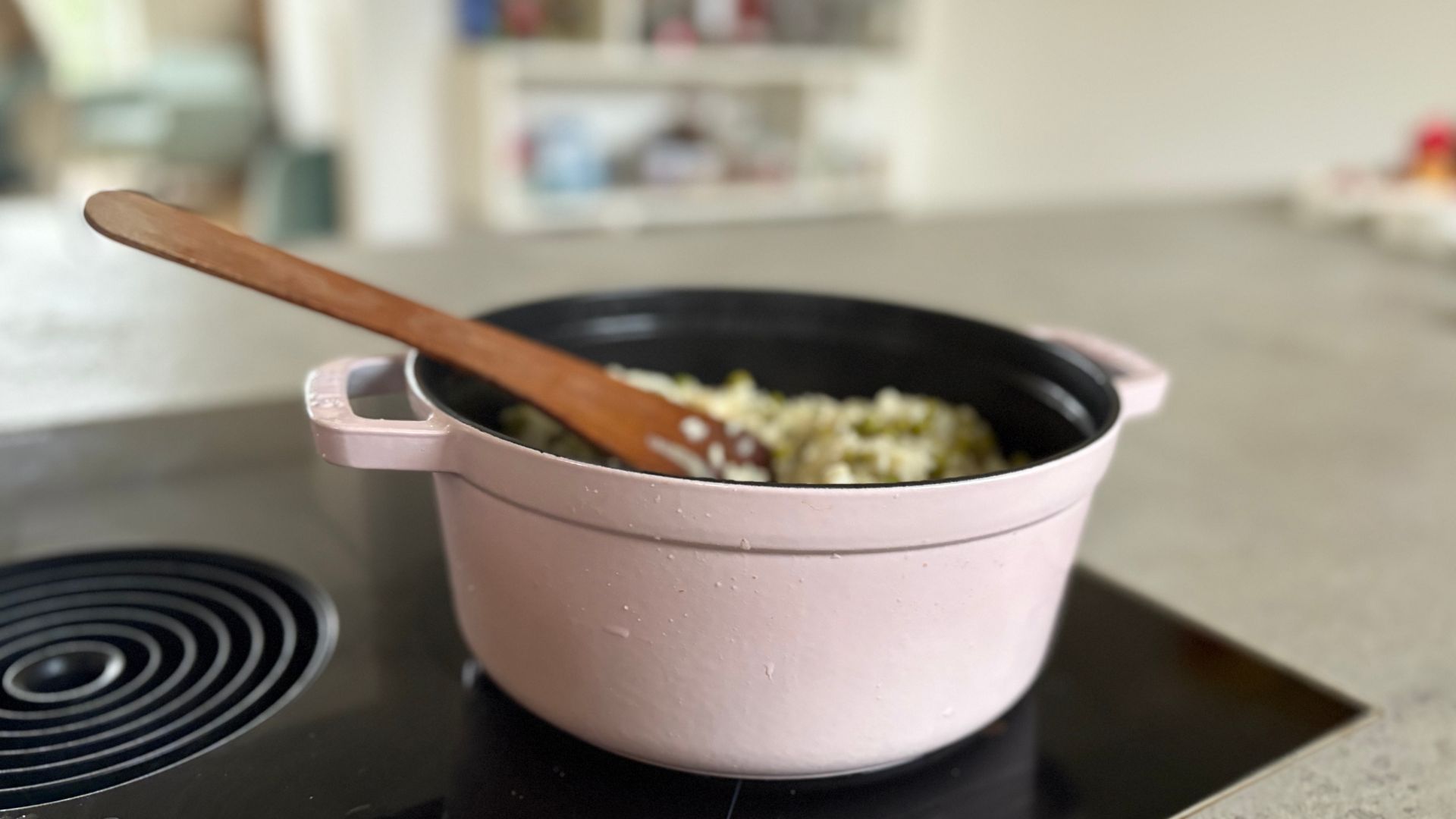
Cooking with the Staub La Cocotte Round Casserole dish is really where the tests amp up. On a general level, this sits well on the stove and is compatible with a full range of cookers. The handles don’t get too hot to lift and they’re roomy enough to loop a hand through. The lid also sits nicely, locking in moisture both through how it’s positioned and also through the clever, self basting bobbles (a not-so-technical term I use).
As with all cast iron, it’s pretty heavy to lift. On paper, it’s heavier than the Le Creuset equivalent and it definitely feels that way too. That’s not to say I couldn’t lift it or that I struggled to get it out of the oven, but you’ll need a firm grip and strong hands (probably don’t use it for boiling a full pan of water either.)
I take my cast iron pans through a series of tests to look at how quickly and evenly they transfer heat and then I’ll look at low and slow cooking as well as how versatile they are. My first test is simple: frying onions.
Test 1: frying onions

The fried onion test is brilliant, because you get a great visual representation of how evenly heat is transferred across the base of the casserole dish, but they’re also the building blocks for lots of my other tests. I put a spoonful of olive oil and two chopped onions in the base of the dish and let them cook.
I could see sizzling on the oil in two minutes and thirteen seconds, which might sound slow, but that’s about the average for a casserole dish. They take a while to warm up, but hold heat extremely well.
My onions browned beautifully and were easy to move around the pan after eight minutes. I didn’t have any issues with sticking or burning. I’ve read that some people struggle to see the browning on food because of the black, rather than cream enamel, but I found it really easy to see when my onions were browning and turning translucent.
Test 2: risotto
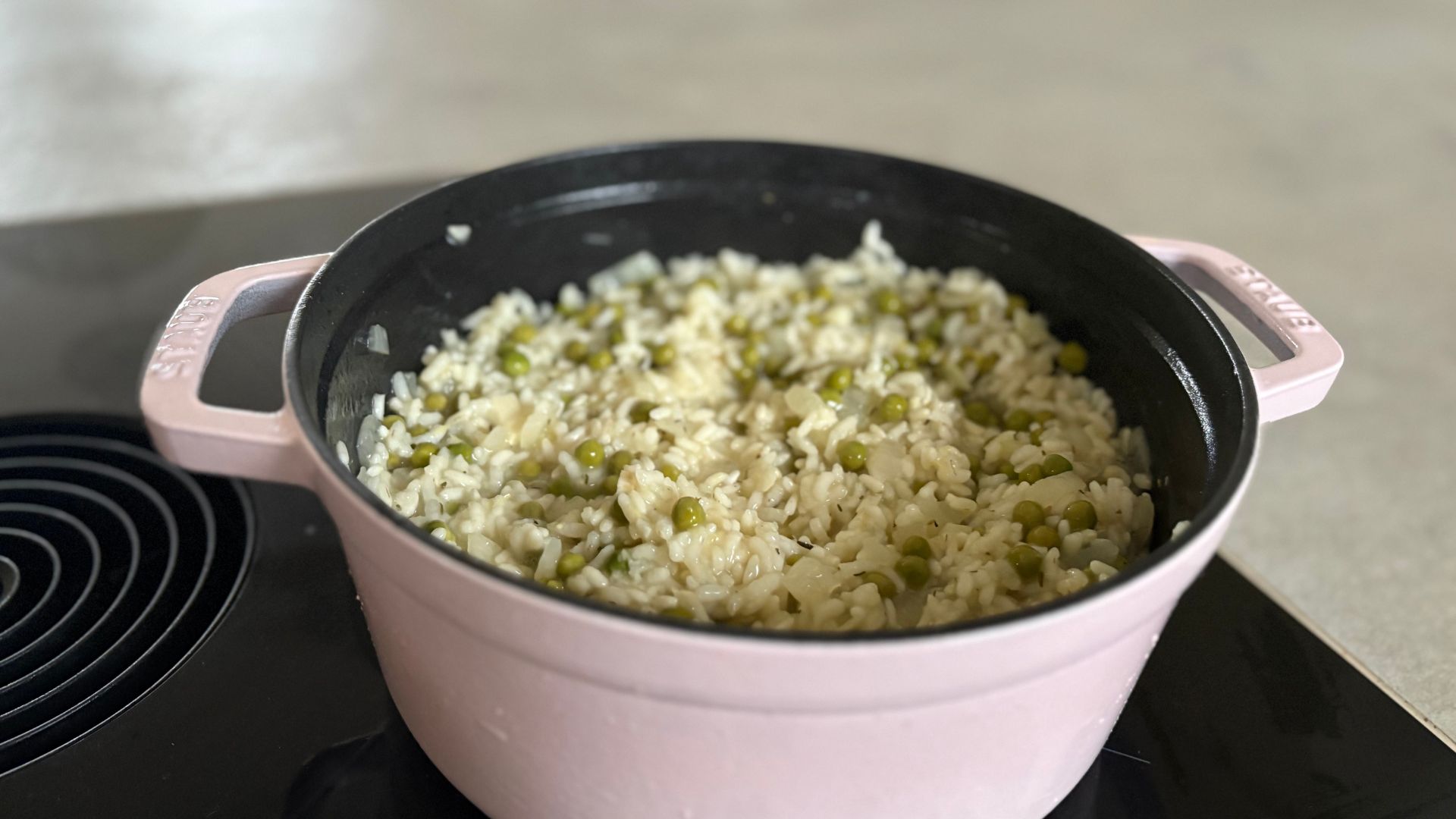
With my onion cooked, I had the beginnings of a great risotto base. I cooked some garlic, added herbs, a little white wine, and some risotto rice with stock. Gradually, I added more and more stock as the rice was absorbing it and tenderising.
It’s pretty common for risotto rice to stick to the bottom of the pan on low and slow cooks like this, but the Staub La Cocotte Casserole Dish kept my rice moving around nicely. I think the combination of enamel and my clever basting lid meant the rice really got maximum juiciness as I normally have to add a little extra stock to the recipe, but not here.
It all cooked beautifully and I was really pleased with the end result. It’s the perfect risotto and I was able to go from start to finish in 40 minutes, which is brilliant for this sized risotto. For context, I got 10 servings out of it.
Test 3: casserole
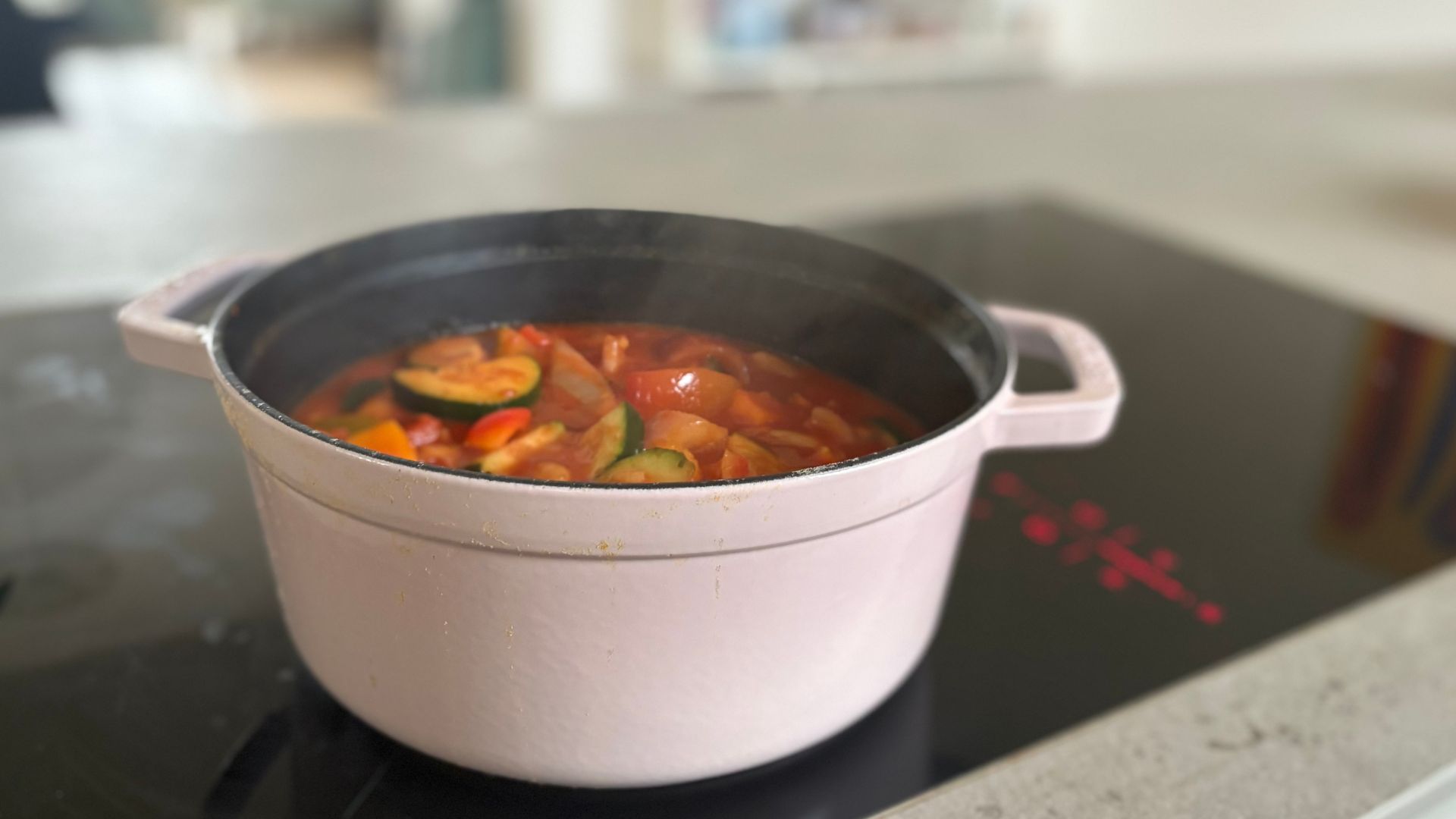
Whilst we’re on the note of slow cooking, I can’t test a casserole dish without making a casserole. This follows a similar start to the risotto in that I need heat for toasting before doing anything. I added my oil and spices to the base of the pan and fried them for a minute. The pan still had residual heat from cooking my risotto and being cleaned, so it warmed up much quicker.
Then, I added in tomato paste, chopped tomatoes, wine and stock. All that boiled and bubbled together until I could add my casserole vegetables, pop the lid on and leave it on a slow heat for 40 minutes.
When I lifted the lid, water poured off. However, the clever design protected my arms from scalding on the hot water. The vegetables were tender and, again, nothing had stuck or burnt at the bottom.
I actually made enough to turn this into a dumpling stew in the oven the next day and the Staub La Cocotte Cast Iron did a similarly good job at not burning all along the base (which I have been known to do).
Test 4: stir fry
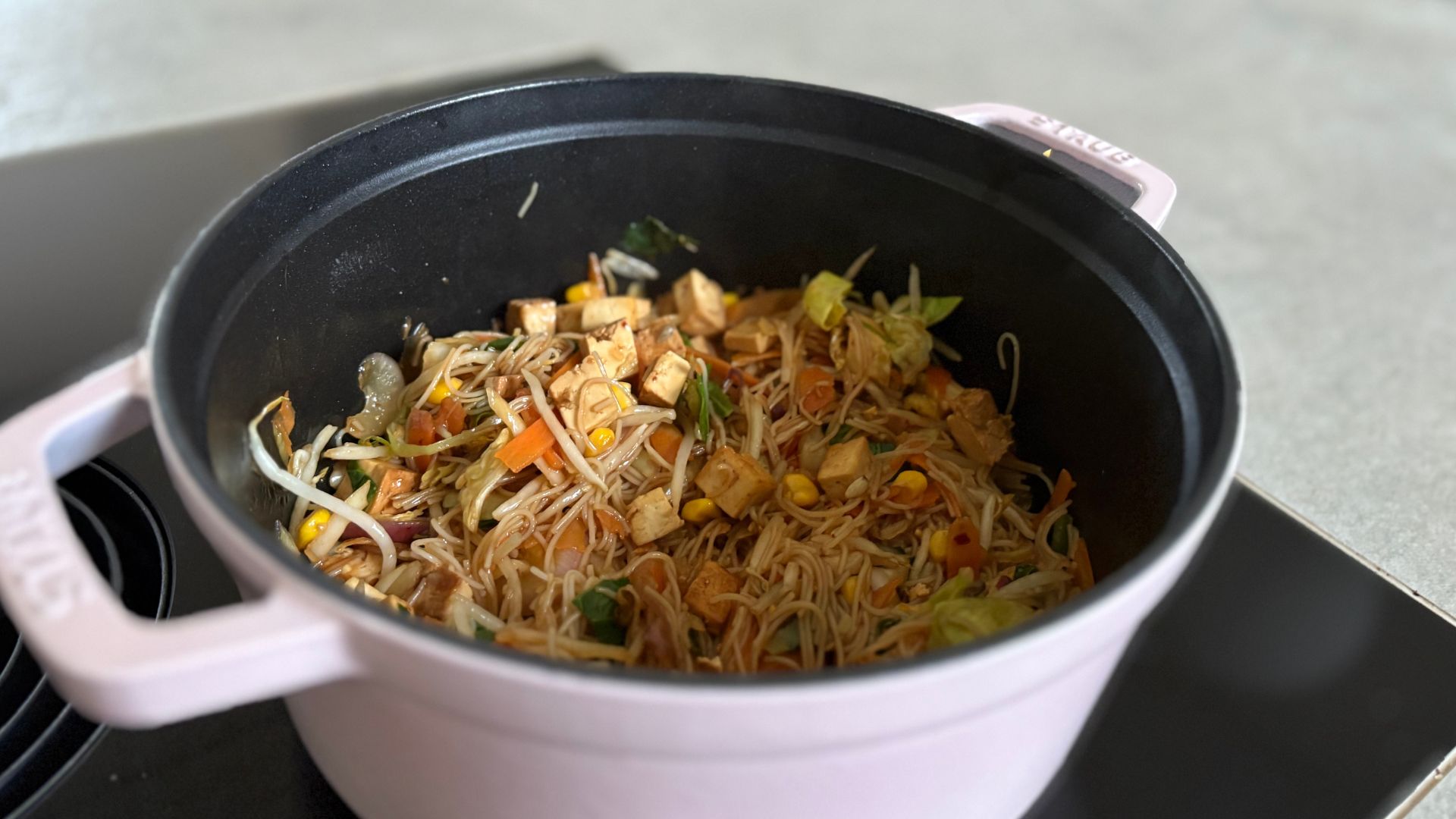
Cast iron casserole dishes are more famous for slow cooking, but I also wanted to run some more everyday tests with the Staub La Cocotte Cast Iron.
When I turned my induction hob onto full power, I had the sesame oil sizzling in a minute. That’s speedy. In fact, it didn’t even give me enough time to chop my tofu to add in.
Once I’d caught up with my tofu prep, I browned the tofu in the oil. These crisped up quickly, within a couple of minutes, which is what they’d do in my wok. Then, I added my vegetables, stirred them for four minutes, before adding my noodles and sauce for the final minute. It felt a little unconventional making stir fry in a cast iron casserole dish, but I’ve actually been converted. This was easy, clean, and my stir fry tasted like it had been cooked in a wok, except I didn’t have the faff that comes with cleaning a wok.
Test 5: soup

Another quick heating task that I ran was warming soup up, but I made this part of a larger, more indulgent soup test. First, I put all my soup ingredients in the oven, treating the Staub La Cocotte Cast Iron Casserole Dish like a roasting tin. At this point, because my oven is shallow and low down, I noticed the weight of the Staub as a limitation, but it’s not quite enough to put me off wanting to repeat my soup test again.
My vegetables roasted in the Staub La Cocotte Cast Iron for half an hour at 180 degrees, until the tips looked charred and I couldn’t see the skin on my vegetables softening. Then, I added in hot vegetable stock and used a stick blender to whizz up the vegetables, in my hot Staub La Cocotte (holding the pan with oven gloves). The black enamel is safe for sharp utensils - I checked - and this is a really simple way to make soup, from scratch, without creating loads of washing up.
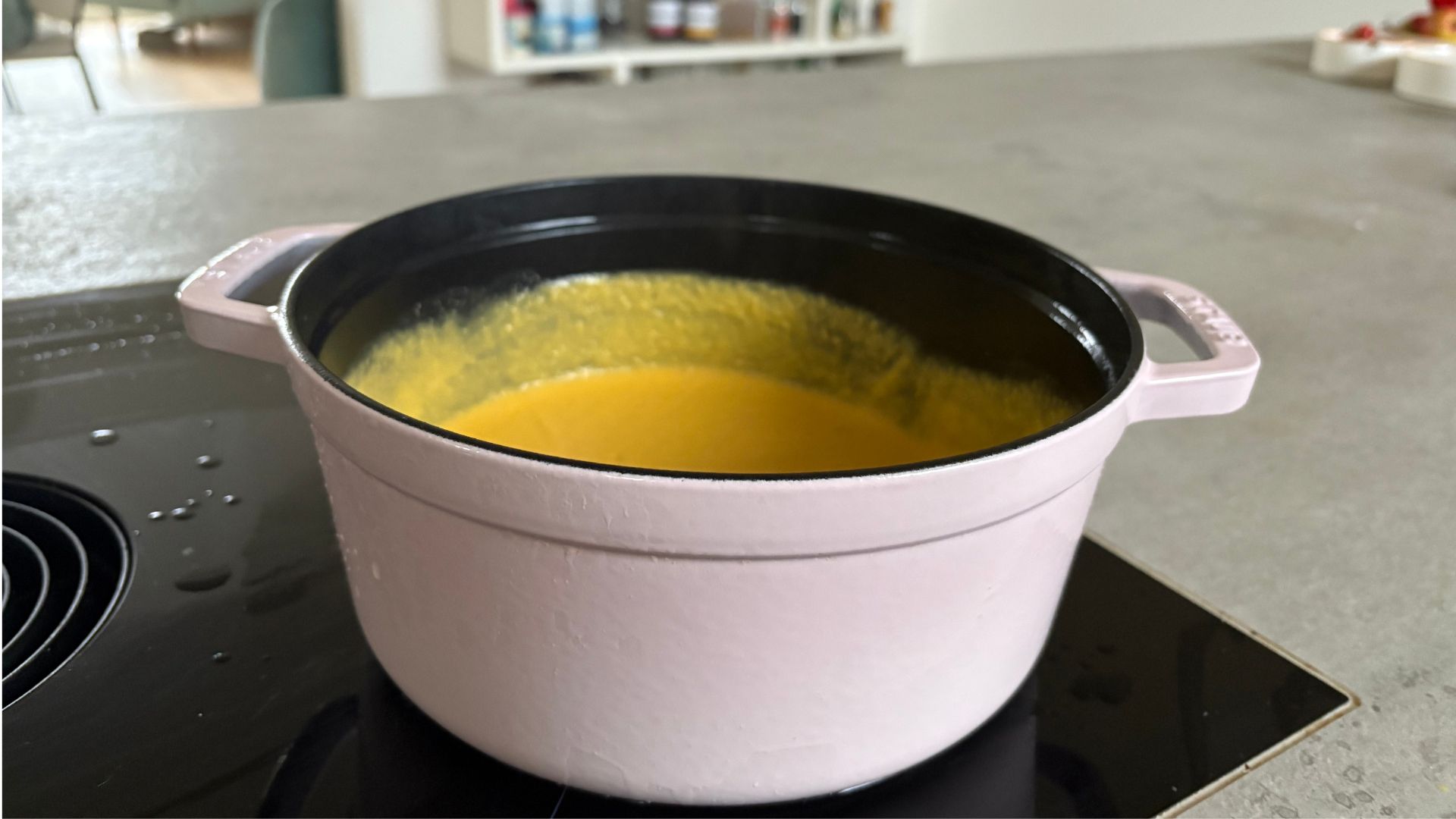
I actually enjoyed this so much that I made multiple different soups over the course of a week and then used the Staub La Cocotte to warm them up for our lunches. Aesthetically, the black looks great with all the soups, from the bright and colourful butternut squash and pea soups to the hearty potato and leek numbers. I really liked serving up soup on the table in this, because the look is so perfect, it felt like I had done lots of work to make this look good, but all I had actually done was pour soup into a pretty casserole dish.
Test 5: roasted vegetables
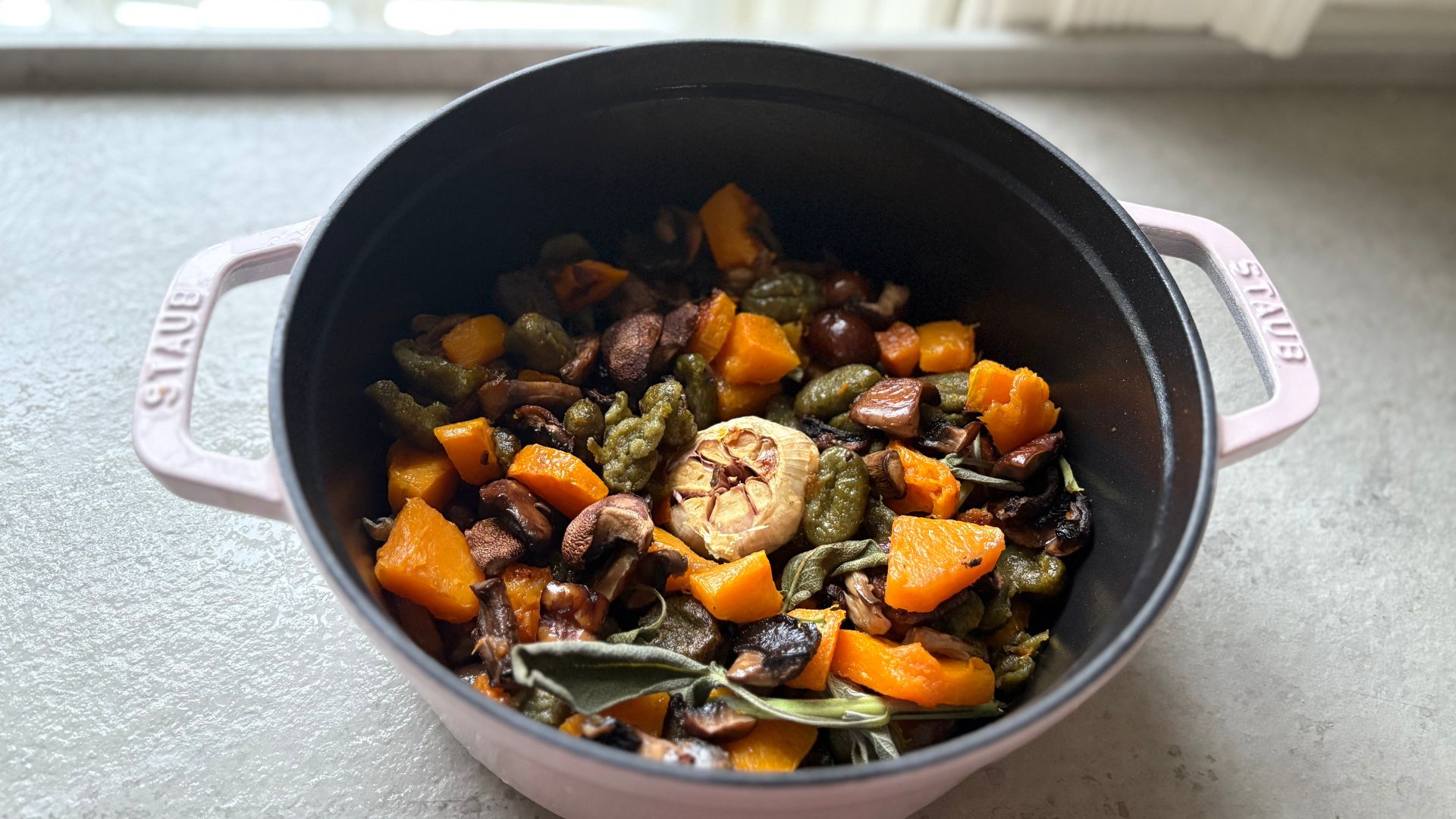
Last, but by no means least, was my test for roasting vegetables and gnocchi. I actually cooked the gnocchi in the Staub La Cocotte Cast Iron (in spite of saying that this isn't really the pan for boiling water) and it did a great job. Normally, it only takes two minutes for me to cook gnocchi and, in fairness to the Stab, this one only needed three.
I drained the water, added mushrooms, chestnuts, butternut squash, sage, and a garlic bulb with a drizzle of olive oil too. That all went into the oven for thirty minutes and came out looking impressive. In my roasting tray, sometimes this needs a little dressing up, but I think it looked great straight out of the oven. My only issue was getting some of the soft gnocchi off the base, because it had caught on when cooking in the oven. The black enamel means you can get more of a scrape and scratch than if this was a Le Creuset, but mine was pretty cemented on, so I did lose some of my crispy gnocchi, but not much. And I think it was worth it for how stunning this looks. Don't you?
Cleaning the Staub La Cocotte Round Cast Iron Casserole Dish
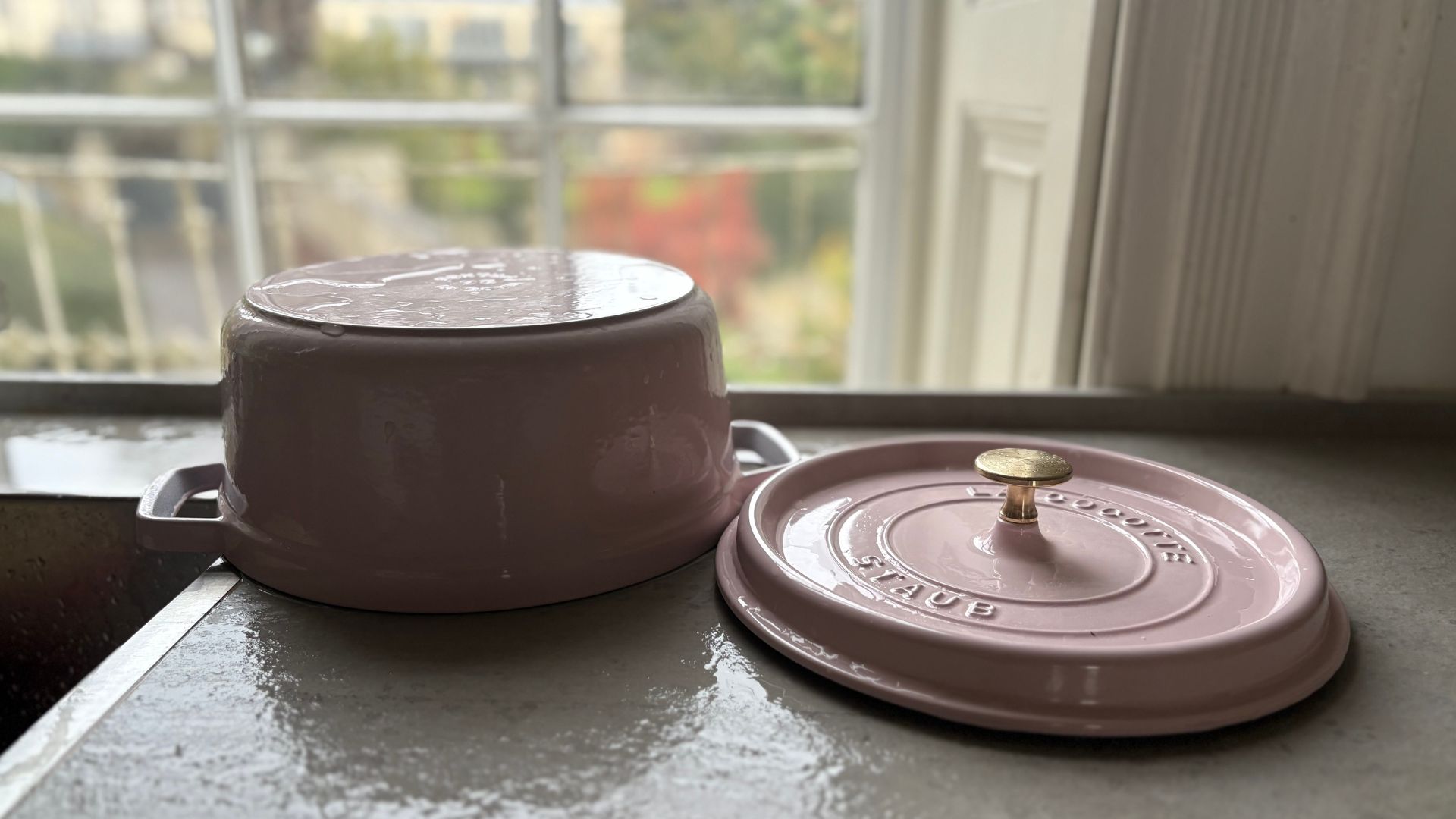
Most cast iron casserole dish brands will tell you not to put yours in the dishwasher and I would have to agree. These are pieces that should last a lifetime in your kitchen, so it’s worth protecting them from the unaware ferocity of your dishwasher. However, the Staub La Cocotte is a rare exception. This is completely dishwasher safe, so you can load it in and then let the jets and tablets do your dirty work.
If you've happened to burn something onto the enamel (I got my gnocchi stuck), leave some water to soak on the base and everything will loosen and soften up in under ten minutes.
The black enamel is generally very forgiving, but that doesn't mean that you shouldn't clean it carefully and thoroughly. I'd also recommend being extra-gentle on the exterior, as I scratched mine a little with the inside of the lid and the outside of the casserole dish. It's all part of the love, but be careful.
If you want some specialist advice on careful cleaning, we have a whole page dedicated to how to clean a cast iron skillet without damaging it.
How does the Staub La Cocotte Round Cast Iron Casserole Dish compare?
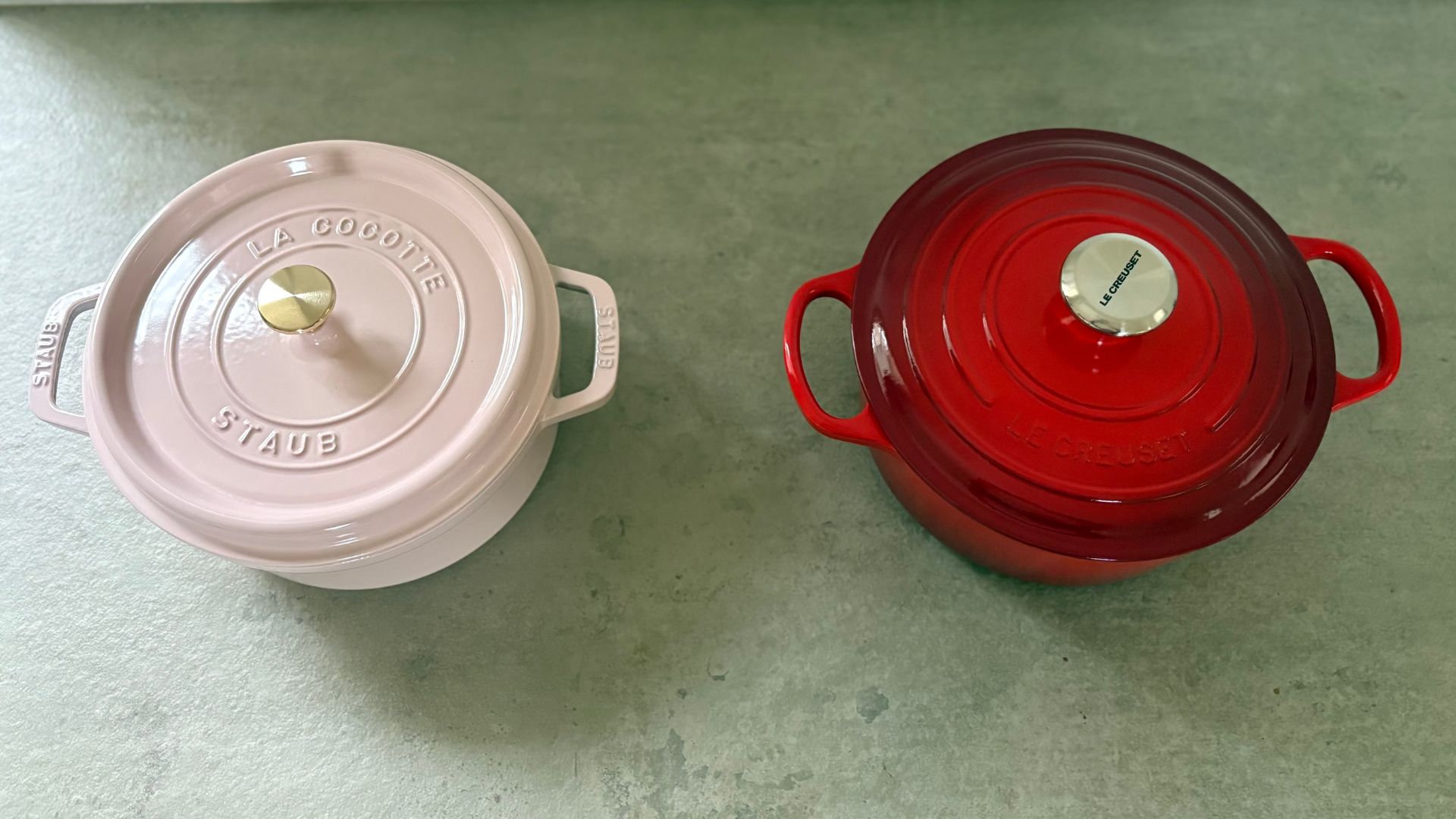
Now we get to the question you've all been asking: is the Staub La Cocotte as good as a Le Creuset Round Casserole Dish. If we take a typical 24 cm diameter (4.2l capacity) round casserole dish from both Le Creuset and Staub here are the numbers:
| Row 0 - Cell 0 | Staub | Le Creuset |
Diameter | 24 | 24 |
Capacity | 3.7L | 4.2L |
Weight | 4.74 | 4.31 kgs |
Colour options | 16 | 20 |
Oven safe | Up to 260 ºC | Up to 260°C |
Composition | Cast iron and enamel | Cast iron and enamel |
Guarentee | Lifetime | Lifetime |
I'll give you a little context on what those numbers feel like in real life. Both cast iron casserole dishes have generous handles, they look really impressive, and they transfer heat well. Performance wise, they're really neck-and-neck. The Staub La Cocotte is a little more chunky, which also plays out in how much heavier it is. I definitely felt the difference on my wrists, especially when taking this in and out of the oven. I expected this to also give the Staub La Cocotte better heat retention and heat transfer, but, if anything, it's a little slower. You also have less capacity inside the Staub La Cocotte too.
On the flip side, the Staub La Cocotte (£279) is £40 cheaper than a Le Creuset Round Casserole dish (£319) and I did enjoy having a little more space on the handles. The dark enamel inside is much lower maintenance than the Le Creuset. I often find myself holding my breath whenever I use the light enamel of a Le Creuset and I also didn't mind the darker colour. Some say it makes it harder to see whether food is cooked or not, but I didn't find the same.
Having done the exact same tests in both Le Creuset and Staub, I can see why it's a fierce debate. Both casserole dishes feel ultra-premium and they do a fantastic job of heat transfer. Staub is a little chunkier and more rustic, whereas Le Creuset has elegance and colour options on its side, but you can't go wrong with either in my book. And, if you like cooking large joints of meat, make sure to take a look at Le Creuset's unique oval cast iron casserole dish.
Should you buy the Staub La Cocotte Round Cast Iron Casserole Dish?

It's easy to see why the Staub La Cocotte has become a classic in French kitchens. It boasts style, substance, and a sizeable price tag. If you're a keen cook, it's well worth investing in and loving it for a lifetime.

Laura is woman&home's eCommerce editor, in charge of testing, reviewing and creating buying guides for the Homes section, so you'll usually see her testing everything from the best dehumidifiers to sizing up the latest Le Cruset pot. Previously, she was eCommerce editor at Homes & Gardens magazine, where she specialised in covering coffee and product content, looking for pieces tailored for timelessness. The secret to her heart is both simplicity and quality. She is also a qualified Master Perfumer and holds an English degree from Oxford University. Her first editorial job was as Fashion writer for The White Company.
You must confirm your public display name before commenting
Please logout and then login again, you will then be prompted to enter your display name.